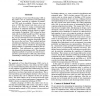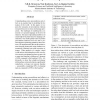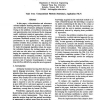688 search results - page 63 / 138 » Using reinforcement learning to adapt an imitation task |
IJCAI
2001
13 years 9 months ago
2001
One advantage of Case-Based Reasoning (CBR) is the relative ease of constructing and maintaining CBR systems, especially as a number of commercial CBR tools are available. However...
ACL
2012
11 years 10 months ago
2012
Comprehending action preconditions and effects is an essential step in modeling the dynamics of the world. In this paper, we express the semantics of precondition relations extrac...
COLING
1992
13 years 9 months ago
1992
In this paper, a discrimination and robusmess oriented adaptive learning procedure is proposed to deal with the task of syntactic ambiguity resolution. Owing to the problem of ins...
CDC
2010
IEEE
13 years 2 months ago
2010
IEEE
Abstract-- We consider reinforcement learning, and in particular, the Q-learning algorithm in large state and action spaces. In order to cope with the size of the spaces, a functio...
GECCO
2005
Springer
14 years 1 months ago
2005
Springer
In neuroevolution, a genetic algorithm is used to evolve a neural network to perform a particular task. The standard approach is to evolve a population over a number of generation...



